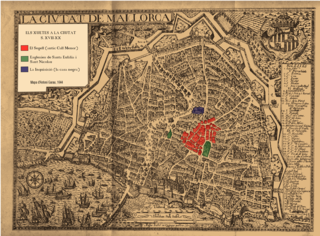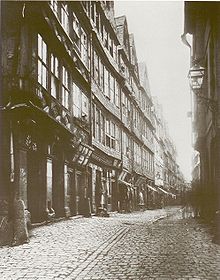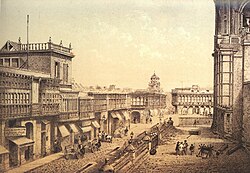
The Old City of Jerusalem is a 0.9-square-kilometre (0.35 sq mi) walled area in East Jerusalem.

A mellah is the place of residence historically assigned to Jewish communities in Morocco.

Giudecca is an island in the Venetian Lagoon, in northern Italy. It is part of the sestiere of Dorsoduro and is a locality of the comune of Venice.
Aljama is a term of Arabic origin used in old official documents in Spain and Portugal to designate the self-governing communities of Moors and Jews living under Christian rule in the Iberian Peninsula. In some present-day Spanish cities, the name is still applied to the quarters where such communities lived, though they are many centuries gone.

Moroccan Jews constitute an ancient community. Before the founding of the State of Israel in 1948, there were about 265,000 Jews in the country, which gave Morocco the largest Jewish community in the Muslim world, but by 2017 only 2,000 or so remain. Jews in Morocco, originally speakers of Berber languages, Judeo-Moroccan Arabic or Judaeo-Spanish, were the first in the country to adopt the French language in the mid-19th century, and unlike the Muslim population French remains the main language of members of the Jewish community there.

The Jewish Quarter is one of the four traditional quarters of the Old City of Jerusalem. The area lies in the southwestern sector of the walled city, and stretches from the Zion Gate in the south, along the Armenian Quarter on the west, up to the Street of the Chain in the north and extends to the Western Wall and the Temple Mount in the east. In the early 20th century the Jewish population of the quarter reached 19,000.

Beginning with the invasion of Poland during World War II, the Nazi regime set up ghettos across German-occupied Eastern Europe in order to segregate and confine Jews, and sometimes Romani people, into small sections of towns and cities furthering their exploitation. In German documents, and signage at ghetto entrances, the Nazis usually referred to them as Jüdischer Wohnbezirk or Wohngebiet der Juden, both of which translate as the Jewish Quarter. There were several distinct types including open ghettos, closed ghettos, work, transit, and destruction ghettos, as defined by the Holocaust historians. In a number of cases, they were the place of Jewish underground resistance against the German occupation, known collectively as the ghetto uprisings.

The Muslim Quarter is one of the four sectors of the ancient, walled Old City of Jerusalem. It covers 31 hectares of the northeastern sector of the Old City. The quarter is the largest and most populous of the four quarters and extends from the Lions' Gate in the east, along the northern wall of the Temple Mount in the south, to the Damascus Gate—Western Wall route in the west. The Via Dolorosa starts in this quarter.

Fes Jdid or Fes el-Jdid is one of the three parts of Fez, the second largest city of Morocco. It was founded by the Marinids in 1276 as an extension of Fes el Bali and as a royal citadel and capital. It is occupied in large part by the historic Royal Palace, which was once the center of government in Morocco and which is still used on occasion by the King of Morocco today. The district also contains the historic Mellah of the city. Since 1981 it has been classified, along with Fes el-Bali, as a UNESCO World Heritage Site.

The Frankfurter Judengasse was the Jewish ghetto of Frankfurt and one of the earliest ghettos in Germany. It existed from 1462 until 1811 and was home to Germany's largest Jewish community in early modern times.

The Xuetes are a social group on the Spanish island of Majorca, in the Mediterranean Sea, who are descendants of Majorcan Jews that either were conversos or were Crypto-Jews, forced to keep their religion hidden. They practiced strict endogamy by marrying only within their own group. Many of their descendants observe a syncretist form of Christian worship known as Xueta Christianity.

In the early modern era, European Jews were confined to ghettos and placed under strict regulations as well as restrictions in many European cities. The character of ghettos fluctuated over the centuries. In some cases, they comprised a Jewish quarter, the area of a city traditionally inhabited by Jews. In many instances, ghettos were places of terrible poverty and during periods of population growth, ghettos had narrow streets and small, crowded houses. Residents had their own justice system. Around the ghetto stood walls that, during pogroms, were closed from inside to protect the community, but from the outside during Christmas, Pesach, and Easter Week to prevent the Jews from leaving at those times.

La Giudecca was a term used In Southern Italy and Sicily to identify any urban district where Jewish communities dwelled and had their synagogues and businesses.

Moroccan Jews are Jews who live in or are from Morocco. Moroccan Jews constitute an ancient community dating to Roman times. Jews began immigrating to the region as early as 70 CE. They were later met by a second wave of migrants from the Iberian peninsula in the period which immediately preceded and followed the issuing of the 1492 Alhambra Decree, when Jews were expelled from Spain, and soon afterward, from Portugal. This second wave of immigrants changed Moroccan Jewry, which largely embraced the Andalusian Sephardic liturgy, to switch to a mostly Sephardic identity.
Jewish Quarter may refer to:

The Jewish Museum Frankfurt am Main is the oldest independent Jewish Museum in Germany. It was opened by Federal Chancellor Helmut Kohl on 9 November 1988, the 50th anniversary of Kristallnacht.
The 1948 bombings in Cairo, which targeted Jewish areas, took place during the 1948 Arab–Israeli War, between June and September, and killed 70 Jews and wounded nearly 200. Riots claimed many more lives.
Salomo Abraham Taroç was a 14th century Sephardic Jewish physician and money lender.

The Mellah of Marrakesh, formerly known as Hay Essalam is the Jewish Quarter (Mellah) of the city of Marrakesh, Morocco. It is the second oldest of its kind in the country.

The Jewish quarter of Barcelona in Barcelona, Spain, is an area located in the Gothic Quarter. The quarter was the heart of the city's Jewish community from the 7th to 14th centuries and was one of the most important Jewish quarters on the Iberian Peninsula during the Middle Ages.



























